Interview: Darkest Dungeon 2's new 3D look, monsters, The Narrator, and its surprising 'aspirational' spirit
New details on the direction of the sequel, and what shape we should expect it in under Early Access release.
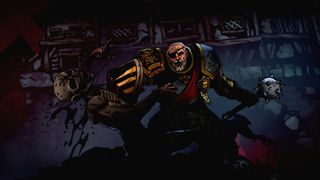
Last week we learned that the follow-up to one of our favorite turn-based games of the last decade, Darkest Dungeon 2, is arriving next year in Early Access. But we still don't know much about how it will play, where it takes place, or what big changes to expect. What's up with the icy mountain we saw in 2019's trailer? Will I still have to fight terrifying soup? What new characters will we send to die?
Although we're still waiting for these hard details about systems, setting, and characters, I had a chance to prod Red Hook Studios' co-founders Chris Bourassa and Tyler Sigman about the general direction this sequel is taking, as well as its inspiration and the development process so far. Darkest Dungeon 2, as it turns out, is changing in some unexpected ways.
Discussed in this interview:
- What going 3D means for Darkest Dungeon
- The creative direction of monsters and heroes
- Why Darkest Dungeon 2 might be less depressing than you'd think
- Don't expect identical ominous voice lines for narrator Wayne June
- How Red Hook is managing Early Access, and the expectations of a sequel
The interview has been edited for clarity and brevity.
PC Gamer: Last year you told me that Darkest Dungeon 2 would be a game about "enduring a grueling journey, not cleaning up your backyard." More than a year later, what more can you tell us about that concept?
Chris Bourassa, creative director: We wanted to make sure this game provided a different experience to Darkest Dungeon. An analogous one, a familiar one, but still not an identical one. And so we sort of set out with this broad kind of vision statement for what that would look like, and I think we're really in the thick of discovering what that means.
Tyler Sigman, design director: I think we wanted to make a real demarkation that it wouldn't feel just like a big DLC. It would feel like a sequel.
The biggest gaming news, reviews and hardware deals
Keep up to date with the most important stories and the best deals, as picked by the PC Gamer team.
Often we see sequels deliberately kind of flip the table on players' expectations, on habits they've developed, and certainly Darkest Dungeon is not a game where players are often allowed to get comfortable. Is that where you're headed?
CB: I think we have a rich tradition of table flipping.
I think if the first Darkest Dungeon is about going deeper and understanding how much worse things can get at each step, this game is about clawing up out of it. And so it's going to be Darkest Dungeon, it's not going to be easy, it's not going to be forgiving, we're not going to hold your hand, all of those things remain true.
But it has an aspirational thread that the nihilistic older brother didn't have. It's trying to get somewhere, it's trying to accomplish something, and above all it's faint, and distant, and the journey to get to it is extremely tough, but it's there. So this game is more about reaching towards something precious than it is sort of exploring how far down the staircase goes.
"We want to pack the game with new awful monsters."
TS: Part of Darkest Dungeon's DNA is the fallibility of humans. Viewers are human and all that, but there's always been kind of a potential uplifting part there in terms of flawed. Flawed heroes are still heroes.
CB: Yeah. Really I think the message that we're trying to push on the sequel is that if you can't sit around waiting for the level 100 paladin to ride in on a white horse, you look around and you're like, "Well, this is who we've got, and so it's going to have to be good enough." And I think that really is what heroism is. It's people who don't know if they can do it trying to pull it off. It's the attempt that's heroic actually. If you already know you're going to succeed, that isn't heroic at all.
Going 3D
The biggest thing we see in the latest trailer is the apparent switch to 3D characters. It kind of surprised me because Darkest Dungeon's 2D art is so singular. Is this just an aesthetic change or is there a deeper purpose?
CB: It's a couple of things. Pragmatically from a craftsmanship standpoint, people have consumed the art that I drew for 1.0 and the art that the team made beyond that in the DLCs along with me. And so we had to look for a way of invigorating this game, and giving it legs, and generating a similar kind of excitement, and I'm speaking purely visually for this.
So that was one of the main practical considerations. But the most important thing above all is to maintain the distinctive style of the game, and only leverage technology and sort of 3D modeling animation effects if they are enhancing that style or evolving it, not trampling on it. And so we did a bunch of research, and experimentation, and played around, and the result is in the teaser. Those are in-game models captured out of Unity, which is the game engine, so there's no post processing other than color correction on one or two of them. But that's what we're working with, and it was important to just try to even grow the characters up a little bit.
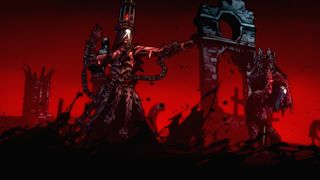
And what impact will the move to 3D have on the combat mechanics? Should I expect to be fighting in a similar way, is that experience intact?
TS: We didn't want to throw everything out and rebuild the game from scratch. We think Darkest Dungeon combat is still really cool. The side-on positional skills is just part of the game's identity, and so that's staying.
Some of the mechanics, some of the stats, they're kind of different. We're handling accuracy in a different way because some of the stuff that was maybe either clunky or we wanted to improve... I think interpretation of the combat is really important, and so we wanted to try to push things forward a little bit in terms of finding ways to refine the mechanics, strengthen them, and tighten those up.
Characters & monsters
So far we've seen seven characters—Grave Robber, Hellion, Highwayman, Leper, Man-at-Arms, Plague Doctor, Occultist. What can you say about the rest of the roster? What is that going to look like in terms of old versus new?
CB: I said this the other day: when you play Street Fighter 2, you get to know the cast, and then when you play Street Fighter Alpha 3, you expect to see many of your favorites, but they'd be remiss if they didn't adjust the roster with some new stuff, and I think philosophically that's kind of where our head has always been at. It was an extremely difficult process to even rank the heroes internally.
We're keeping anything new kind of close to the chest for now, but we should have a pretty robust roster, I think, for early access launch. I think people would be happy with the choices that we've made, and probably disappointed that some of their favorites aren't in right away.
But is it fair to say we'll see new faces in the early access launch, not just existing characters?
TS: Yes.
CB: It's very fair. A very fair thing to say.
What about monsters—do you plan to bring some of those enemies back?
CB: It's easier to describe what we don't want to do quite frankly. We don't want to wholesale bring back every single favorite monster, and every single favorite hero. That would be a disservice to the audience quite frankly, and it would not be nearly as exciting for us as creators. So we want to pack the game with new awful monsters, hopefully some new classics emerge from that mix, certainly currently we've got a few favorites.
However, we also don't want to leave absolutely everything behind, and so I think we have some really exciting kind of clever ways. Everything ranging from little nods to the first game to reinterpretations, and a new representation of an old classic. So we're trying to run the gamut of ways we can call back to the first game, but just like how we approach our character designs at Red Hook, we want to do it in a way that's clever and just not trite and expected.
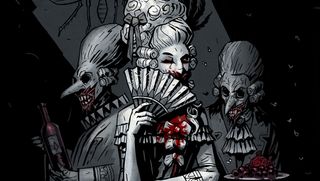
I don't want to be evasive because I'm actually really excited about some of the choices we've made around that, but I think people are going to be really, hopefully, impressed and kind of have a grin on their face when they see some of the things we've done in this area.
TS: To me, the monsters are a more straightforward process and organic, because they're driven by environment. If you look at the first one it's like, "If we want to do an underwater area, The Cove, what kind of monsters would live in The Cove?" And I'm like, "Well, The Ruins was the first thing that makes sense to be right below the estate, so: skeletons." And so by nature of transplanting the setting, it makes some of those decisions for you because you're like, "Well, would the Cove guys be wandering around this place? Yes or no?" It's pretty easy to figure that out.
I think it's safe to say that there will be a lot more new faces on the monster side than the character side just by nature of how we're building everything.
One of the most surprising things we've seen so far of Darkest Dungeon 2 is from your trailer in 2019, which shows a massive white mountain environment. But of course in this more recent trailer, we see what looks like the estate, what might be the beginning of Darkest Dungeon 2. What can you say about the relationship between those two areas and the kind of "journey" you're talking about?
TS: We're keep some big reveals, close to our chest, which of course we're excited to eventually share more. But—
CB: We'll call you.
TS: But I think that the big burning scene that's in the new trailer, it feels a little bit like the world right now, and I think regardless of where you fall maybe politically or whatever, I would say everyone probably feels a lot of upheaval right now. And so we didn't look at the outside world and say, "Oh let's make a game about it." But I think it's impossible not to be living through certain things, and not have that become part of the creative expression. Or put another way, it's pretty easy to get emotional research done on what a, "Oh my god, the world is burning down," hypothesis. So I think that's definitely part of the setup.
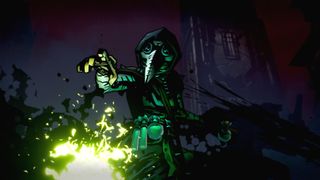
CB: I've seen on Reddit, there's a couple of people going like, "Yeah. They started with this mountain, and now it's a city. They just threw away the mountain." Please. Like it's not our first rodeo. We didn't throw the mountain away.
To get somewhere, you've got to go through some stuff, and so I think what we're providing a look at in the new teaser is one of the things you've got to go through to get where you want to go.
Other than the state of the world right now, as you mentioned, are there any other games that you've found an inspiration from?
CB: We talked a lot about Fury, the tank movie.
Because we really liked the fact that there were these kinds of evolving character interactions [in Fury] set against a backdrop that none of them could really control, but they may all have a sort of a shared goal as a group, and then a personal character arc. So those three stages to that movie, the war effort, the specific mission, and then the specific relationships between all the different people stuck together no matter what, and they're not all compatible, and I think that was early on. I think we both watched that movie separately, then we watched it again together at Tyler's place, and I think I watched it the third time, and it just sort of seemed to click like, "This feels right." It's a smaller cast, but they're deeper characters, I guess.
TS: Yeah. And it takes all four or five of them to make the tank run, which I thought was really interesting, and there's some parts in there where they're like, "Why do we have to do this thing?" And Brad Pitt is like, "Because we've been ordered to do it, and we're going to do it."
Modding
Circling back to the decision to go 3D, I think about the healthy modding community around Darkest Dungeon. Some players have expressed concern that 3D will limit modders' output.
TS: Our first focus is just on making a product that we're super proud of. So, I would say in the same way that we approached it in the first one, which is we like to see the mods, we're super happy, and we try to eventually arm them with lots of tools, but that came after finishing the game. So our first focus is on making the game, and then hopefully enlarging the amount of tools that are available.
"People, I think, mistakenly say Darkest Dungeon is super, super, super hard."
But on the non-art side, I think the hope is still that there's a lot of files that people can get in there, and change skills, and change things that can happen, and make items and all that kind of thing. If the first game is any hint too, people are just going to figure this shit out. In the first game, they had to get in and use find, and learn how to cut up all the things to make animations, like our team member Brooks did in crazy ways, and they make some insanely cool stuff. So, I'm sure they'll find a way.
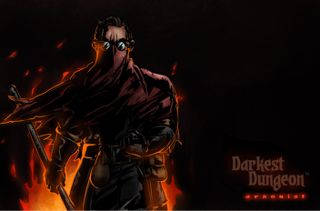
CB: Yeah. I think we have a track record of support the modding community, and trying to make their lives easier wherever we can. But like Tyler said, it starts with a really good game that they want to mod, and I think part of... Deciding not to make the same game again, deciding to change significantly things around presentation, mechanics, keeping the signature stuff, but really taking a step back and trying to chisel at what the new game has to be, that exposes us. Those are risks that we're taking. And I think that's important, and I think that's where you get the best creative output. It's a little uncomfortable as a creator. Believe me, it would've been a lot easier to just draw more side view things forever.
And I will say too that the tools around 3D... we launched in 2015, it is a different world. There are free tools for 3D, there are so many different exporters out there, and I think that the acumen and the toolkits are just so much more robust on the internet now than they were even like five years ago. So I feel like it's not as dire as maybe some people might be concerned about.
Early Access
Let's talk a little bit more about early access. What is your best estimate of what the game is going to look like in its early access launch next year? Will I be able to go from beginning to end?
CB: I want to say that Darkest Dungeon 1 launched with 58 percent of the 1.0 content. There was a lot to come. When you look back, we added extra bosses to every zone, we added way more playable characters, we added two entire dungeons, bosses for those dungeons.
So, I feel like that is a similar target for us. We want to launch with about, I'd say 60 percent, but we want that 60 percent, like we did with the first time out, present itself well, reward your time in it, not be buggy, be a really cool game in and of itself, and just grow it over the course of early access in terms of its content breadth, and learn the same lessons around it to many of the feature sets that we did on the first game.
TS: We've both had a chance to talk a lot about early access, which I'm proud of because when we launched into early access, there had been just a couple of high profile, I guess we can call them failures or whatever, where people had to cut bait and they were like, "Yeah. We were going to do more, but we're just going to release this and call it 1.0." And so there was an overall sentiment of, "Is early access really a good thing?" I don't feel like there's that discussion anymore.
People aren't like, "Should early access exist?" I don't hear those discussions anymore. So in the times we've talked about it, the rule of thumb I've given you is 60 percent content. But I will say, I think the systems and all that needs to be higher. I think those need to be like 80, 85 percent because content is wonderful to drop in. As we learn, when you have to make system changes, great, but it's a little more chance of shocking the system. That's not going to make us shy away from it despite all that because one of the big lessons we've learned is just communicate better.
One of the differences with Darkest Dungeon 2 is that although the game will release on Steam once it hits 1.0, you're going to be on the Epic Games Store for your early access debut. Can you talk about that decision?
TS: We respect each fans' decision to make of where they want to play the game and when. We're not going to tell them how to feel or how they should or shouldn't be excited, but our focus is on making a great game, and it's early access exclusive, but it's not permanently exclusive. So we want to get the game in everybody's hands eventually. That's definitely our plan.
CB: Our whole focus is just how to make something. That's the best way to honor any community is to give them something that you believe is really great, and we'll engage them and inspire them, and that's where our heads are at.
TS: I don't think a lot of people understand the knife edge that can be for even a successful company to go from riding high to failure. It can literally mean one product that didn't sell as well especially when you're small. We're not making five games to diversify our portfolio. We are all in on one game, and that's what we did the first time, and that's what we're doing this time, and I think it's just you need to do what you can to try to give yourself the best chance to keep making those games in the event that a game isn't received as well as you would hope, and we certainly didn't go into this going, "We have a sure hit on our hands with DD2." We feel a deep sense of responsibility and fear to make a good game, and that's important for us because I think that's how, in my opinion, a good game is made.
CB: And if we're afraid of doing something wrong or afraid of out-spending or afraid of... If we're trying to hold back, we're not in the same headspace, we're not going for it, we're just trying to do it. And I think to circle it back, I think the nature of the Epic deal very much supports and enhances that productive mentality of, "Now let's just go for it. What could we do? We'll just make this as cool as we can." And it alleviates some of that other stuff that, I think, is kind of destructive.
So all that considered, how has the development of the sequel been? Has it been hard to recreate the lightning in a bottle of the first game, or not?
CB: I think that for me, I realized very early on there was no recreating. And if I was thinking about trying to recreate lightning in a bottle, I would fail. So I tried to put that aside. I think it's been challenging to work with a bigger team. What was a quick conversation and fast implementation is... We're not as agile as 25, 27 people as we were at five or six, but we can accomplish much more together. Our top speed is much higher, but our ability to swing around the corner super, super quickly is not.
But I think what hasn't changed, and this is super on the record, is Tyler and I are making this game right alongside the team. We didn't opt for a structure where we would staff up and then back away. I am painting textures, I am doing concept art, I am writing it, Tyler is tuning, designing in there on the build. We're accountable to the schedule the same way everybody else is, and I think that was something that we said from the get-go is vitally important. Neither one of us want to maintain the machine that makes games, we want to be inside that machine right next to everybody else on the staff, and I think that is the best way we can preserve.
TS: Yeah. Darkest Dungeon did well enough that we could have tried the traditional path of, "Now we can try to become a 100 person studio." For us, it's all about the product, and to do a different thing, we needed to hire more people. But that was a means towards creating the game we want as opposed to sort of defining... Because we've seen many, many studios where growth is their measure of success.
Or they become a publisher.
TS: Yeah. We actually had discussions about that, and we talked ourselves out of it. We like boutique game production. I think Supergiant comes to mind as someone who's ahead of us on this journey. Supergiant has done well enough that they could be a two game at a time company, no questions. Especially now with Hades.
Difficulty
A lot of players fixate on Darkest Dungeon's difficulty as its defining aspect. How do you think the conversation around difficulty has changed in the four or five years since it came out?
CB: When we started [on Darkest Dungeon], I think it was interesting because being difficult was newsworthy in a sense, and I don't think that's the case anymore, but I think that's natural. Being pixel art was newsworthy for a period of time. Now it's just a choice. I don't think it's good or bad, but no one is going to pay attention to you purely because you use pixels or purely because you were difficult.
People, I think, mistakenly say Darkest Dungeon is super, super, super hard. We try to be unexpected, and we try to take some risks where we'll take away a character from you on a coin flip that you spent a bunch of hours, and that goes against conventional game design wisdom.
It was never intended to be hard just to be hard.
That's not difficulty in the sense of being uncompromising, and so I think uncompromising doesn't ever really go out of style the same hard for its own sake does or certain trends in color palettes. We had a couple of years there where everything was magenta and cyan. Cool. So, I feel like if you keep your game about something primal, it won't maybe fall entirely into one of these categories. And I think the underdog, straining, and reaching, and clawing towards something good is something we can all relate to and maybe something we all need to think about a little bit more right now, and I think that making that difficult rewards the gratification it comes later, but it's not hard just to be hard, and it was never intended to be hard just to be hard.
TS: I think we're insulated or maybe purposefully isolated from trend chasing. A good example is when we started Darkest Dungeon, conventional wisdom would have been try to make a free-to-play game or be on a different platform or make it mobile, and we purposefully and intentionally were like, "No. All the momentum, all the money, and all the investment, we couldn't get investment when we started Darkest Dungeon, we didn't have a name cache." We know we had a lot of experience, and we weren't doing something trendy. We were not doing something that would make a venture capitalist or an angel investor say, "Oh, I'm going to 100X my return or something."
So we were like, "We're going to make a game where we charge $20 bucks, and you own it, and it plays like an old-style game." And it's mean, it's not forgiving, and it's fantasy, and dark, and all that stuff. And so, I think it's not that we're not aware of trends. We play games. In fact, the more there's a trend, the more we kind of... I just want to put my head down.
CB: Except for Battle Royale. Tyler tried hard to get us to make Battle Royale, unironically, for about eight weeks.
The Narrator
So coming back towards content, obviously Wayne June's performance is just an inseparable aspect of the game. It's the prevailing meme for Darkest Dungeon, and you just see people quoting it all over the place where you guys are, which is very fun, and it doesn't get old somehow.
TS: It's crazy.
How are you writing The Narrator this time? If the structure of the game is changing, is he changing as well as a character?
TS: We were just having these discussions.
CB: I think that he has... And I don't want to change the voice when we say that. I don't want [him] to be putting on a crazy accent or something, and just say it's still Wayne June. I want him to sound like he sounds, but let's walk it back—does it make sense to be on this grueling journey trying to hold it together, and trying to just get to where you got to go, and have somebody be these pithy, sardonic sayings every step of the way? I don't think so. That doesn't feel like it reinforces our core vision. And so we want him speaking in a way that, perhaps it's a little more affirmative.
It's still clever, it's still dark, but he's got to keep you moving. That's really all I can say about it. Just like any other aspect of the game, we want to make appropriate adjustments to reinforce the creative goals that we're trying to chase down.
TS: We agree the narrator is part of Darkest Dungeon's identity. Let's put it that way.
CB: But do we want him saying like, "Overconfidence is a slow, blah, blah, blah."? You've heard it. You don't need to hear it again. I could write it with different adjectives. It just doesn't land, and it echoes the artwork. Just drawing it again won't do the same thing that it already did.
You've played those notes.
CB: Just rephrasing the clever quips, it'll die on the vine, man. I don't even want to do it. I'm so convinced that it would be bad that I don't even want to try to just paraphrase my own self again.
Do you think that will surprise players? This familiar brooding voice is inseparable from Darkest Dungeon.
CB: I have to believe that it will. I have to trust that we can create something familiar and foreign, exciting and interesting, and still Darkest Dungeon. We came up with it the first time out, we've got to be able to do ourselves right. But maybe one of those areas where people are surprised, but we can't give them the same game again. We just can't do it. It won't be fun to make, and ultimately they don't want that. I believe, personally. We could record 1,000 more lines of dialog that say the same stuff again, but I don't think that's really what people want. They want a glitz, a new look into this place. So that's what we're really attempting to give them on all fronts.
TS: I feel like we had a breakthrough recently on that where it takes time for these things to gel, and I'm personally excited last time we talked about it. I think there is a lot of interesting things for him to say that aren't just like you were saying like, "Don't be an idiot."
CB: I love a good sound bite, and so that's still the guiding factor. I was very happy when the "buffoon is flummoxed" thing landed pretty nicely on the PvP DLC. It's still got the quips.
I do want to mention, just because it's so recent and has been so successful on Kickstarter, the board game that you guys have launched with Mythic Games. What has your involvement been?
TS: Mythic wasn't actually the first partner we worked with, but the other one didn't work out and Mythic approached us with an interest and the license. One really key thing for us is we didn't want it to be a skin. Actually, I'm sure we had pitches that people were like, "Hey, we've got a game system. I think Darkest Dungeon would fit well on it." It's like, no, that is the total opposite of how we design even the video game. The mechanics need to be made in service of the game, not the other way around.
Anyway, Mythic, there's this just great ... There's a lot of happy accidents in Darkest Dungeon's development, but similar with this, Mythic has been rising. I had backed a couple of their games or Solomon Kane had wanted to back Joan of Arc, but missed the campaign or whatever. I was aware of their existence, but they had a couple of designers. I don't know if they already worked for them or whatever, who were just Darkest Dungeon fans and had been working on their own Darkest Dungeon board game adaptation without commercial intent, just like hobbyists/fans.
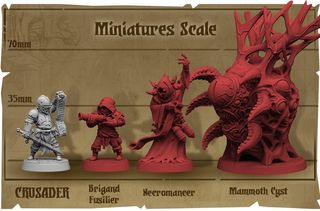
They had to make a prototype and get our buy-in on it. We care a lot. We control everything that comes out Darkest Dungeon wise. We've been intimately involved, but it's them that have done the work, you know? It's been fun. Chris can speak to the art side of it too.
Following along the Kickstarter, I've almost been able to do it like a fan because we didn't make it all, so we get to experience part of that. There was a little pressure of when someone does a license, the whole economic question is, we think we can sell more copies, even though we have to give away some of the money than without a license.
CB: Yeah. That's a great way to put it actually because I'm looking at the updates and oohing and awing over them as they come out. I don't know what update is coming up next or what stretch goal is going to happen. It's neat.
Thanks for taking the time to talk through all this with me.

Evan's a hardcore FPS enthusiast who joined PC Gamer in 2008. After an era spent publishing reviews, news, and cover features, he now oversees editorial operations for PC Gamer worldwide, including setting policy, training, and editing stories written by the wider team. His most-played FPSes are CS:GO, Team Fortress 2, Team Fortress Classic, Rainbow Six Siege, and Arma 2. His first multiplayer FPS was Quake 2, played on serial LAN in his uncle's basement, the ideal conditions for instilling a lifelong fondness for fragging. Evan also leads production of the PC Gaming Show, the annual E3 showcase event dedicated to PC gaming.
Most Popular





